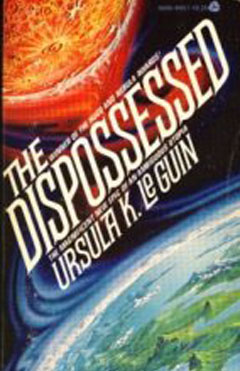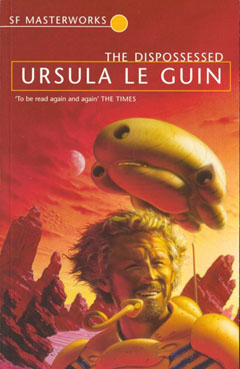

Home | Spaceship Earth | Book Reviews | Buy a Book | Bean and Grain Index | Short Stories | Contact | Mud Blog
7/6/2007
A Review of Ursula Le Guin's Sci-Fi Classic
"Distrust everything I say. I am telling the truth..."
Ursula Le Guin published what many call her best work, The Dispossessed, in 1974. It was an immediate success. It captured science fiction's highest honors, the Hugo and Nebula Awards, and was later reissued in 1999 by Orion Millennium as part of their SF Masterworks collection. Even in the vast imaginative spectrum of science fiction, The Dispossessed is a unique piece, a quiet manifesto, given to long discussions of ideas. It is sometimes slow, sometimes difficult reading. But it is also important and inspired writing–and in no small way a forward looking, sociological, political, and environmental statement born of the cultural revolution of the 1960s. Together with The Left Hand of Darkness (1969), The Dispossessed made Le Guin the preeminent woman writer of science fiction. It also had many readers calling her a visionary for her daring advance of feminist ideas and grim projections for the future of industrialized society.


Despite the accolades, Le Guin decidedly turned away from the label of social seer. "Science fiction," she writes in the introduction to the second edition of The Left Hand of Darkness (1976), "is often described, and even defined, as extrapolation. The science fiction writer is supposed to take a trend or a phenomenon of the here-and-now, purify it and intensify it for dramatic effect, and extend it into the future." Le Guin then makes it very clear that extrapolation is not what her writing is about and that she doesn't know what the future holds any better than anyone else. Extrapolative science fiction, she says with a little edge, with a hint of attitude, perhaps disturbed by the way The Dispossessed was being interpreted, is not really that much different than what the Club of Rome did when they funded an MIT research team to make a computer model to project what another 100 years of economic growth would do to planet Earth. That was extrapolation, and extrapolation invariably ends, she adds, much like the Club of Rome's publication The Limits of Growth, with "the gradual extinction of human liberty and the total extinction of terrestrial life."
Le Guin goes on to say that she has been invited to several conferences for futurologists, where there are apocalyptic graphs or compiled statistics pointing to this or that horrible outcome. She felt out of place at these conferences, she confesses. Her work did not fit this kind of thinking. She merely uses the metaphors of science fiction to write about the "now." If anything, she concludes, you should read her work as "thought experiments." Which essentially, she suggests, is what all novels are. If such and such were true, this is how it would look. And this is precisely what Le Guin does.
In The Left Hand of Darkness, Le Guin's thought experiment begins with the premise that long ago there was a highly advanced and essentially human race of people living on the planet Hain. They systematically toured the surrounding galaxy and visited other habitable planets, appraising alien life and culture, colonizing some planets, even experimenting genetically on others. Tens of thousands of years have passed since that time; new societies have arisen and matured on eighty-four of these planets. As each planet is different in climate and natural resources, the resultant communities evolve in their own individual way and are effectively independent geo-social experiments. When these societies reach a certain level of sophistication, they are contacted by the descendants of the original Hainish explorers, and one by one are brought into a federation of world governments known as the Ekumen. This generally peaceful and stable interstellar scheme is the backdrop for The Left Hand of Darkness and many other Le Guin novels including The Dispossessed. It is a platform that allows her to perform thought experiments with various social premises or biological settings on one planet or another within the Hainish realm, one of which is our Earth, called Terra.
The Dispossessed takes place on Urras, one of the original eighty-four planets, and its companion planet, Anarres. Urras is much like Earth, a garden planet, with a rich materialist society and a stratified class structure. Anarres has been the uninhabited sister planet to Urras, something like our moon, until some one hundred and seventy years prior to the story, when the Urrasti shipped a group of dissident anarchists off to Anarres with an agreement to never return. The climate is so harsh on Anarres that the modest colony is only maintained by strict communal agreement among the Anarresti and limited trade with Urras. Eight times a year a freighter from Urras delivers petroleum, machine parts, and electronic components to Anarres in exchange for copper, gold, tin, uranium, and mercury. Society on Anarres is stark and severe like its environment. The Anarresti don't use money or have ownership. Everything that is necessary is shared equally. Mining, agriculture, all labor is similarly divided equally. Much of the book's intellectual investigation, its thought experiment, centers on the differences between the societies occupying these two planets–capitalist Urras contrasted to anarchist Anarres.
The plot-line follows the life of a theoretical physicist, Shevek, who lives on Anarres and is working on what is referred to as a General Temporal Theory that will unify the ideas of sequential time and all-time-at-once simultaneity. There is hope that the application of Shevek's theory will open the door to faster than the speed of light communication and travel. And because of this world-altering work, Shevek is a scientist of great interest and envy to many of the planets within the Ekumen.
In a move of historical consequence, a group of academics from rich and powerful Urras invite Shevek to their planet to do research in its prestigious university system. Shevek accepts the invitation, despite strong sentiment against it on Anarres, and becomes the first descendent of the originally dispossessed people to return to the homeland. The Urrasti, hoping to lure this man to Urras permanently, try to seduce the great scientist to their way of life with modern convenience, opportunity, and luxury. In the end, Shevek finds the Urrasti materialism petty and rejects the premise of their society. He even participates in a contained revolution with working class Urrasti before going back home to desolate but egalitarian Anarres.
In the full circle of the story, the reader experiences the cultures of both planets through the chronology of Shevek's life, his childhood friends, his sexual experiences, his family, his work, and his own strong and creative individualism. Le Guin does this with such artistry and detailed description, the two imaginary worlds become fully actualized and real, providing the basis for an unusually engaging piece of science fiction.
Many of the reviews and commentaries on The Dispossessed focus on Le Guin's depiction of the anarchist society of Anarres. The common image of anarchy is madness let loose upon the streets. This is a superficial if not simplistic view. Anarchy means without government or law. Disorder is not a necessary outcome of anarchism, and drawing this for us, a working anarchy, is where Le Guin's vision is the most evocative and masterful. While there are certain social guidelines to which the inhabitants of Anarres must adhere, the presiding ruler is not a human but the austere climate of the arid planet's environment. If life is to sustain on Anarres at all, it is only through dedication to the group and their stark communalism.
Le Guin's study of Anarresti life is often praised because she draws her picture of their anarchist society so realistically, including both its utopian hopefulness and its limitations and flaws. Despite the rejection of government, a bureaucracy and a hierarchy does evolve on Anarres in spite of itself. And it is this sometimes stifling bureaucracy, along with a desire to spread his ideas throughout the federation of worlds, that inspires Shevek to leave his home and risk the trip to Urras. Thus we are given a critical and vivid picture of the anarchist society through the eyes of the disaffected Shevek. And it is this narrative device, Shevek's begrudging objectivity, that makes Le Guin's utopian novel so convincing.
But Le Guin's book is more than a study of this "ambiguous" utopia, as she calls it. Labeled feminist science fiction at the time it was written, The Dispossessed also uses the thought experiment of an anarchist society to delve the dynamics of sexual equality. Gender is not considered a social difference on Anarres. There is no institution of marriage. Relationships last only as long as each member feels that it is working. Sexuality is not repressed. There is no stigma attached to homosexuality. And all work is done communally. Everyone, man and woman, must spend a certain number of days of the year contributing to the manual toil of securing food, mining, or other jobs of necessity. Once those responsibilities are fulfilled, the individual can pursue whatever he or she wants. And the barren planet of Anarres runs rather smoothly without excess, without luxury, without money, without individual property, and without government, but with strong commitment to the community. As Shevek declares in a heated discussion with a friend, "This planet wasn't meant to support civilization. If we let one another down, if we don't give up our personal desires to the common good, nothing, nothing on this barren world could save us. Human solidarity is our only resource." This solidarity is the foundation of the anarchist society. And a message that might well be taken to heart on planets that struggle to maintain the human contract though possessing far grander material resources.
This is one of the things that anarchist Shevek witnesses on "propertarian" Urras. Despite the planet's natural wealth, Urrasti society reflects a clear financial stratification, a male dominated culture, and waste. Farseeing Le Guin puts further emphasis on this by relating the history of another planet in the Ekumen, our Earth, described from some distant future. An ambassador from Terra by the name of Keng lives in the Terran Embassy on Urras. In a conversation with Shevek toward the end of the book, she tells him the sad legacy of her people who also once lived on a planet as bountiful as Urras.
"My world," says Keng, "my Earth, is a ruin. A planet spoiled by the human species. We multiplied and gobbled and fought until there was nothing left, and then we died. We controlled neither appetite nor violence; we did not adapt. We destroyed ourselves. But we destroyed the world first. There are no forests left on my Earth. The air is grey, the sky is grey. It is always hot."
Le Guin, who was acutely aware of publications like The Limits of Growth (1972) and Paul Urlich's The Population Bomb (1968) at the time she was writing The Dispossessed, was clearly voicing concern to her readers for what she feared was in Earth's future if more forethought didn't go into resource management. The Terran ambassador goes on to tell Shevek how things are on her planet now, after the crash. "We saved what could be saved, and made a kind of life in the ruins, on Terra, in the only way it could be done: by total centralization. Total control over the use of every acre of land, every scrap of metal, every ounce of fuel. Total rationing, total birth control, euthanasia, universal conscription into the labor force. The absolute regimentation of each life towards the goal of racial survival." The austerity of life on Terra was something Shevek of Anarres could easily relate to, but not the centralized authority.
With a vital prescience, Le Guin has imagined life on Anarres in a way that works as a model for life on a planet with limited resources, a reliance on imported petroleum, and regularly occurring periods of drought. The Anarresti civilization is made up of many semi-independent small communities joined by a network of trains and electronic communication. Travel within the community is by foot. The trains are for longer distances and freight. Le Guin tells us this design was created by the political philosopher Odo whose work inspired the initial anarchist uprising that led to the colonization of Anarres:
"Decentralization had been an essential element of Odo's plans for the society she did not live to see founded. She had no intention of trying to de-urbanize civilization. Though she suggested that the natural limit to the size of a community lay in its dependence on its own immediate region for essential food and power, she intended that all communities be connected by communication and transportations networks, so that goods and ideas could get where they were wanted, and the administration of things might work with speed and ease, and no community should be cut off from change and interchange. But the network was not to be run from the top down. There was to be no controlling center, no capital, no establishment for the self-perpetuating machinery of bureaucracy and the dominance-drive of individuals seeking to become captains, bosses, chiefs of state."
Though Odo's ideals are not fully realized on Anarres and the Anarresti society does have its bureaucratic flaws, Le Guin gives us an image of life on Anarres that seems credible and real, a unique and powerful vision of an anarchist society–and a scheme that would apply well to life on our planet should water and/or petroleum resources run low and our society were forced to reorganize around other economic realities. This apt vision alone would make The Dispossessed a remarkable piece of science fiction, but it is more than that.
The Dispossessed is a great book–for its writing, its universal truths, its study of anarchism, and its analysis of the impact of human life on a planet. When read today, it seems remarkably current, touching with stunning insight on issues like climate change, natural resource depletion, sexuality, and alternative social models. And despite Le Guin's own desire not to be seen as a futurologist or a social seer, whether called a thought experiment or a metaphor, The Dispossessed is transcendent because of the accuracy and astuteness of her extrapolative powers. What concerned thinkers are describing today to offset fossil fuel depletion and environmental degradation, decentralization and relocalization, is just what Le Guin depicted in 1974. While it is the "now" that she aimed for in her writing and the timeless relevance of her characters and their conflicts that propels The Dispossessed to the highest echelons of modern literature, that does not make it any less an important visionary work of science fiction–even if Le Guin prefers you not put that feather in her cap.
The Dispossessed is a little known masterpiece. If you haven't read it, read it. If you have read it, read it again.
Jesse Wallace's dilemma is that he knows too much. He knows all the deepest, darkest secrets of the little town of Briley, Oregon. But he can't tell a living soul. He knows the daughter of the town's most successful rancher is addicted to heroin and cocaine. He knows Briley''s highly respected parson is having an affair with a local prostitute. He knows that a sexually active young man is HIV positive, and he's seen two horrible murders. But he can't tell the town sheriff or inform the state police, because one of those murders was his own. Ever hear the story about the ghost in the whorehouse? This is it...

"Sharply drawn, memorable, and touching characters," writes Frank Kaminski, "and, with icy narrative precision, the main villain is utterly frightening and believable. Definitely a masterwork, and one that would reward many re-readings."
BUY NOW for $20.00 plus shipping directly from Mud City Press or from Amazon.com.